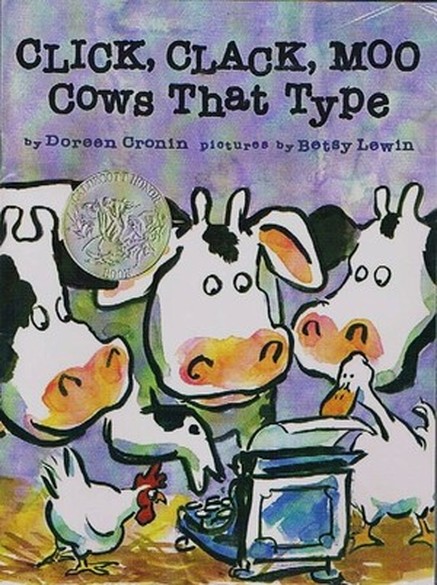Book Title: Click, Clack, Moo, Cows That Type
Author: Doreen Cronin
Illustrator: Betsy Lewin
Publication: 2000
Genre: Poetry (Sound-based, onomatopoeia, rhythm)/Fiction
Award: Caldecott Honors
Amazon Link: http://www.amazon.com/Click-Clack-Moo-Cows-That/dp/1442433701
EDIT:
Since the video is not working, I decided to try to recall what I signed for Vlog and made a Blog instead.
This book is a poetry/fiction - poetry because it utilizes sound-based word patterns, onomatopoeia (click, clack), and rhythm. This book is mostly fiction too - because, cows do not use typewriters in real life, do they?
The summary of the story goes like this: The Farmer Brown had a problem - that cows liked to type! Click, Clack, Moo. Click, Clack, Moo. Click, Clack, Moo. The Farmer Brown wanted to see what were going on, so he went to barn to see a memo typed up by cows - and that they said "dear farmer brown, the barn is cold at night. we would like to have electric blankets, please. sincerely, the cows." The Farmer Brown felt ridiculed by this, and did not honor the cow's request. Upset by the denial from the Farmer Brown, the cows decided to go on a strike by saying "NO MILK TILL ELECTRIC BLANKET"... and what happens next? Feel free to read the book! :D
This book incorporates 6 elements of social justice well - first, self-love and knowledge - it is evident in the cow's behavior. In the book, the cows are cold - recognizes the problem and they decide to approach the problem by requesting an electric blankets. That is not possible without self-love and knowledge - they knew what was needed to be done, and took care of themselves. Second, this book also recognizes respecting others as well. I may be spoiling the story here, but when the cows went on the strike, another animal saw and joined the strike. Normally, if the cows were self-centered, they would not let another animal to participate, but instead, the cows saw the injustice happening to the other animals, and decided to collaborate with them. I think that is a sign of respect for others. Third, this book recognizes the issue of social injustice - it is evident that the cows and Farmer Brown are not equal in this book - the cows are livestock - the animal that are meant to be owned by the Farmer Brown. This could be allegoric with how WASP (White Anglo-Saxon Protestants) and non-WASPs are in the power struggle. Fourth, the book shows the cows are striking against the 'injustice' of Farmer Brown, once again, mirroring the real world's non-violent protests against the ones who are in the power. Fifth, by recognizing the parallel of the cows and Farmer Brown, we become aware of the reality. Lastly, as this book noted livestock protesting against the injustice of Farmer Brown, this book also could indirectly encourage us to stand up for what we believe in, and stand up against the injustices.
With all that being said, I believe this book may be an effective tool to be used along with history class - maybe 3rd to 4th grade - when they get to learn about sociology, and history of civil rights - this book may be harmless yet mirroring the historical event thus allowing children to learn about the reality.

No comments:
Post a Comment